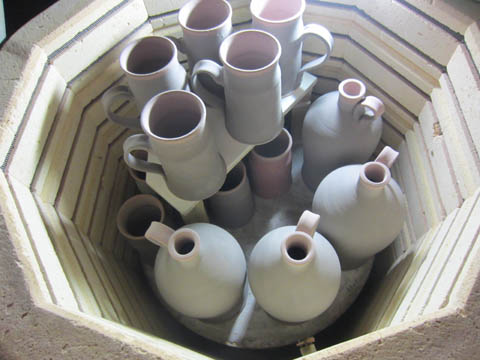Hand Crafted Vessels for Hand Crafted Beer
Thanksgiving may have been yesterday, but we are thankful everyday for many things, including the support for the Spotted Dog Brewery shown by our family, friends, and fans. One of the individuals who has supported the Spotted Dog recently in a big way is North Carolina-based potter Sue Grier--you may have seen some of her pieces around the brewery, including the medallions on our taps. Sue is Jerry's sister, who also grew up in the Mesilla Valley and attended NMSU before moving to the East Coast. As a part of our recently released merchandise, we are proud to include custom beer steins (and a few growlers) that are wheel thrown and hand crafted by Sue. Curious about how the steins were made? Keep reading!
Like any good beer, many carefully calculated steps are required to achieve the final result from what may seem mundane beginnings. The steins begin from a slab of clay, cut into individual pieces.
Once the body of the stein has been thrown on the wheel and the handle added, they must dry before their first firing in the kiln. The clay must go through a firing process to convert to a finished piece of ceramic pottery.
In the first firing, also known as the bisque firing, the steins are stacked in the kiln (see picture below) and fired up to Cone 8, which is a measure of heat. Sue uses an electric kiln for this step, which typically takes 8-10 hours followed by a day of cooling. At this stage, the clay is chemically changed through the firing to become stoneware pottery--but they need a bit of color!
After the first firing, the naturally colored pottery can be glazed to add color. The glazes are mixed from recipes containing feldspars, kaolins, silicas, fluxes & colorants. The 5 gal buckets shown in these photos have the glazes in them ready to use.
The outside glaze is applied first, a process in which the steins are dipped down into the glaze bucket and the growlers get the glaze poured over them to get a good coating. Once they have dried a bit, the interior glaze is poured inside the stein with a cup and then the rim is dipped in the bucket of glaze and they are ready to go back to the kiln!
In the glaze firing, the steins cannot touch one another the way that they did in the bisque firing. This time, they will be fired up to Cone 7 and the firing will take approximately 8 hours, followed by another day of cooling.
So where did the logo come from? The logo was printed out on decals in a standard laser printer and applied to the steins. While the decals are incinerated during the next firing, the logo remains on the stein due to the composition of the ink--laser ink contains iron oxide which is fused onto the stein!
The third firing not only allows Sue to add our logo, but also changes the glaze color to a more muted, satin finish instead of the high gloss. Once they have cooled from the third firing, they are ready to be shipped! Pottery must be double boxed for shipping to prevent breakage--so keep this in mind if you plan to send a stein by post instead of hand delivery!
We are so excited to offer these steins to all of our customers, and we hope you love them as much as we do. They are dishwasher safe, but handwashing may help preserve the vibrancy of the coloration and logo. If you have further questions about the steins or are interested in more of Sue Grier's recent works, please check out her website and facebook page!













